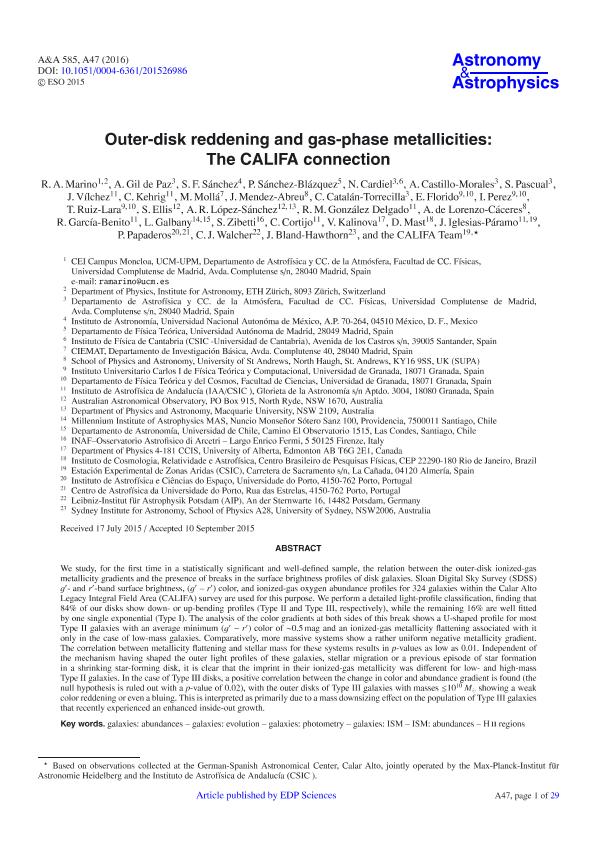Artículo
Outer-disk reddening and gas-phase metallicities: The CALIFA connection
Marino, R. A.; Gil de Paz, A.; Sánchez, S. F.; Sanchez Blazquez, P.; Cardiel, N.; Castillo Morales, A.; Pascual, S.; Vilchez, J.; Kehrig, C.; Mollá, M.; Mendez-Abreu, J.; Catalán Torrecilla, C.; Florido, E; Pérez, I.; Ruiz-Lara, T; Ellis, S.; López-Sánchez, A. R.; González Delgado, R. M.; de Lorenzo-Cáceres, A.; García Benito, R.; Galbany, L.; Zibetti, S.; Cortijo, C.; Kalinova, V; Mast, Damian ; Iglesias Páramo, J.; Papaderos, P.; Walcher, C. J.; Bland Hawthorn, J.; The CALIFA Team
; Iglesias Páramo, J.; Papaderos, P.; Walcher, C. J.; Bland Hawthorn, J.; The CALIFA Team
 ; Iglesias Páramo, J.; Papaderos, P.; Walcher, C. J.; Bland Hawthorn, J.; The CALIFA Team
; Iglesias Páramo, J.; Papaderos, P.; Walcher, C. J.; Bland Hawthorn, J.; The CALIFA Team
Fecha de publicación:
16/01/2016
Editorial:
EDP Sciences
Revista:
Astronomy and Astrophysics
ISSN:
0004-6361
e-ISSN:
1432-0746
Idioma:
Inglés
Tipo de recurso:
Artículo publicado
Clasificación temática:
Resumen
We study, for the first time in a statistically significant and well-defined sample, the relation between the outer-disk ionized-gas metallicity gradients and the presence of breaks in the surface brightness profiles of disk galaxies. Sloan Digital Sky Survey (SDSS) g′- and r′-band surface brightness, (g′ - r′) color, and ionized-gas oxygen abundance profiles for 324 galaxies within the Calar Alto Legacy Integral Field Area (CALIFA) survey are used for this purpose. We perform a detailed light-profile classification, finding that 84% of our disks show down- or up-bending profiles (Type II and Type III, respectively), while the remaining 16% are well fitted by one single exponential (Type I). The analysis of the color gradients at both sides of this break shows a U-shaped profile for most Type II galaxies with an average minimum (g′ - r′) color of ∼ 0.5mag and an ionized-gas metallicity flattening associated with it only in the case of low-mass galaxies. Comparatively, more massive systems show a rather uniform negative metallicity gradient. The correlation between metallicity flattening and stellar mass for these systems results in p-values as low as 0.01. Independent of the mechanism having shaped the outer light profiles of these galaxies, stellar migration or a previous episode of star formation in a shrinking star-forming disk, it is clear that the imprint in their ionized-gas metallicity was different for low- and high-mass Type II galaxies. In the case of Type III disks, a positive correlation between the change in color and abundance gradient is found (the null hypothesis is ruled out with a p-value of 0.02), with the outer disks of Type III galaxies with masses ≤1010 M′ showing a weak color reddening or even a bluing. This is interpreted as primarily due to a mass downsizing effect on the population of Type III galaxies that recently experienced an enhanced inside-out growth.
Archivos asociados
Licencia
Identificadores
Colecciones
Articulos(CCT - CORDOBA)
Articulos de CTRO.CIENTIFICO TECNOL.CONICET - CORDOBA
Articulos de CTRO.CIENTIFICO TECNOL.CONICET - CORDOBA
Citación
Marino, R. A.; Gil de Paz, A.; Sánchez, S. F.; Sanchez Blazquez, P.; Cardiel, N.; et al.; Outer-disk reddening and gas-phase metallicities: The CALIFA connection; EDP Sciences; Astronomy and Astrophysics; 585; 16-1-2016; 1-29
Compartir
Altmétricas



